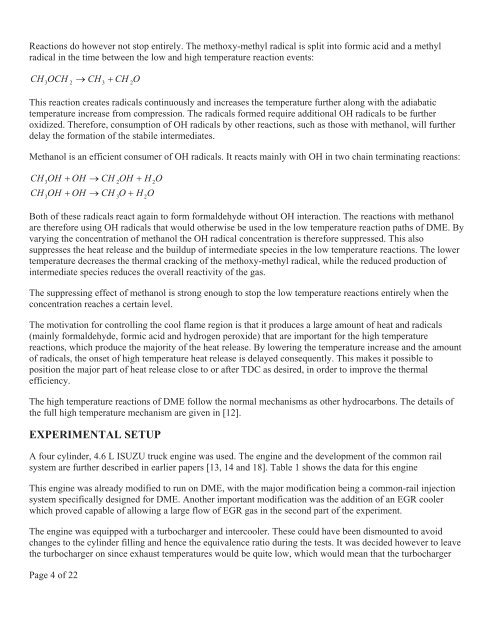Troels Dyhr Pedersen.indd - Solid Mechanics
Troels Dyhr Pedersen.indd - Solid Mechanics
Troels Dyhr Pedersen.indd - Solid Mechanics
You also want an ePaper? Increase the reach of your titles
YUMPU automatically turns print PDFs into web optimized ePapers that Google loves.
Reactions do however not stop entirely. The methoxy-methyl radical is split into formic acid and a methyl<br />
radical in the time between the low and high temperature reaction events:<br />
CH 3OCH<br />
2 CH 3 CH 2O<br />
This reaction creates radicals continuously and increases the temperature further along with the adiabatic<br />
temperature increase from compression. The radicals formed require additional OH radicals to be further<br />
oxidized. Therefore, consumption of OH radicals by other reactions, such as those with methanol, will further<br />
delay the formation of the stabile intermediates.<br />
Methanol is an efficient consumer of OH radicals. It reacts mainly with OH in two chain terminating reactions:<br />
CH OH OH CH OH H O<br />
3<br />
CH OH OH CH O H O<br />
3<br />
Page 4 of 22<br />
2<br />
3<br />
2<br />
2<br />
Both of these radicals react again to form formaldehyde without OH interaction. The reactions with methanol<br />
are therefore using OH radicals that would otherwise be used in the low temperature reaction paths of DME. By<br />
varying the concentration of methanol the OH radical concentration is therefore suppressed. This also<br />
suppresses the heat release and the buildup of intermediate species in the low temperature reactions. The lower<br />
temperature decreases the thermal cracking of the methoxy-methyl radical, while the reduced production of<br />
intermediate species reduces the overall reactivity of the gas.<br />
The suppressing effect of methanol is strong enough to stop the low temperature reactions entirely when the<br />
concentration reaches a certain level.<br />
The motivation for controlling the cool flame region is that it produces a large amount of heat and radicals<br />
(mainly formaldehyde, formic acid and hydrogen peroxide) that are important for the high temperature<br />
reactions, which produce the majority of the heat release. By lowering the temperature increase and the amount<br />
of radicals, the onset of high temperature heat release is delayed consequently. This makes it possible to<br />
position the major part of heat release close to or after TDC as desired, in order to improve the thermal<br />
efficiency.<br />
The high temperature reactions of DME follow the normal mechanisms as other hydrocarbons. The details of<br />
the full high temperature mechanism are given in [12].<br />
EXPERIMENTAL SETUP<br />
A four cylinder, 4.6 L ISUZU truck engine was used. The engine and the development of the common rail<br />
system are further described in earlier papers [13, 14 and 18]. Table 1 shows the data for this engine<br />
This engine was already modified to run on DME, with the major modification being a common-rail injection<br />
system specifically designed for DME. Another important modification was the addition of an EGR cooler<br />
which proved capable of allowing a large flow of EGR gas in the second part of the experiment.<br />
The engine was equipped with a turbocharger and intercooler. These could have been dismounted to avoid<br />
changes to the cylinder filling and hence the equivalence ratio during the tests. It was decided however to leave<br />
the turbocharger on since exhaust temperatures would be quite low, which would mean that the turbocharger

















